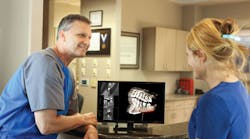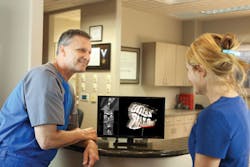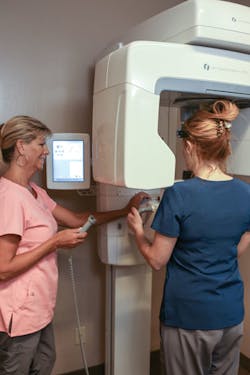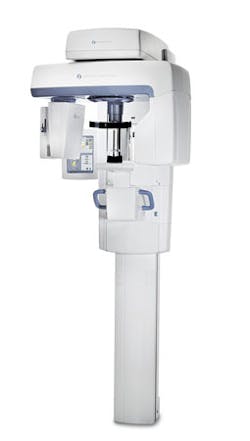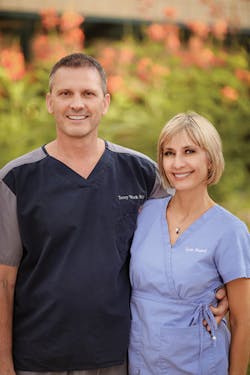Terry Work, DMD
From the very beginning-before I knew about the science or the hours or the compensation that came with a career in dentistry-I knew I wanted to be in a profession where I could care for people. Today, after more than 20 years in dental practice, the patient experience is paramount.
At Dental Works, where my wife and I both practice, we understand that a good patient experience goes beyond being comfortable or the likability of our team. It requires relationship building, earning trust, timeliness, convenience, and results. I'm not now, nor have I ever been, the type of dentist who is into his "toys." There is a lot of cool technology out there that doesn't necessarily make me a better dentist. I don't jump on every bandwagon, and that is why I think my story of embracing 3-D imaging is one you might relate to. In a practice where the patient comes first, 3-D isn't just a choice; it is a necessity.
The patient point of view on 3-D
Sona Reade and her husband have been patients of Dr. Work for close to 15 years. It wasn't a casual decision either; Sona interviewed many other potential practices and chose Dr. Work because "he immediately put me at ease. I felt completely comfortable with him, and his practice seemed to be really well run."
Sona describes herself as "kind of" tech savvy, but admitted that she wanted more out of her dentist. "It is important to me that he and his practice are up-to-date," she said. "Going to Dr. Work means we've never had to go to another dental practice, and we've had a lot of work done!"
The introduction of 3-D imaging has proven especially impressive. "I was considering implant treatment with Dr. Work and the 3-D images he shared with me were absolutely amazing," she shared. "And the process was easier; I never really liked the old X-ray (does anybody?) because it made me gag. This was much less intimidating, and I found myself actually excited about the new equipment.
"Having 3-D images didn't change what Dr. Work already planned to do for my treatment, but it made my experience better. Now I have the most beautiful smile thanks to him and his wonderful staff," Sona continued. "I would refer anyone to Dr. Work, not only because he has all the great new technology, but because the care he offers his patients is unbelievable."
Evolving into a 3-D practice
I'm a general dentist. I spent four years in the Navy, which offered additional training and experience in endodontics and oral surgery, but when I opened my practice in 1993, it was with every intention of being a generalist. Today, we see every type of patient-from pediatric to geriatric-and our practice has a reputation for establishing long-term relationships that allow us to care for everyone. The demographics of our patient base and composition of our workweek are dynamic and evolving, but patient behavior has remained remarkably consistent over the years. One of the things I noticed early on was that patients were reluctant to do treatment that I didn't do myself; they didn't want to go to a different office, different dentist, and establish a new patient record. Over the years, I've done additional specialty training in implant placement and surgical techniques so that now I don't refer out much at all. We are able to do so much here-including IV sedation-that incorporating the 3-D imaging piece became a logical extension of the services we provide.
I've known about CT scanners (primarily on the medical side) for a long time. Years ago, I would send patients to scan centers, and more recently, would bring a mobile CT scanning van to the dental office. I found myself using these services more and more as I came to appreciate and rely on the increased accuracy of a 3-D picture. About two years ago, I was getting more proactive in my equipment research and looking for the right unit at a price point that made sense for our practice. We work with Burkhart Dental Supply, and it was through their team that I was introduced to the Instrumentarium OP300 Maxio. We had a panoramic machine already, but the OP300 Maxio proved to be the ideal unit for our evolving needs. I was tired of sending patients out and "hoping" I'd get the scan I wanted. Having this unit in our office, being able to take both panorex and 3-D images, maintaining a small footprint that worked in our space, and utilizing user-friendly software-all these came together to benefit our practice.
The patient experience
It is so interesting to observe what our patients observe. Our 3-D unit is similar to our old pano in size, so the new equipment didn't intimidate our patients at all. It is in the same spot as the old machine, so the only transition required of them-and of our team-was to be open to a different kind of conversation around treatment recommendations.
Once patients saw the difference between a panorex and 3-D images rich in detail, rotating 360°, it eliminated much of the hemming and hawing built into treatment acceptance. Looking at an old-fashioned X-ray, there is very little recognizable to the patient-just a lot of black, white, and gray. If you show them an X-ray and try to point out bone loss, they don't get it. But a CT scan where you can put bone in and show them where there is a hole in the bone? A light comes on and they see what you're saying. Typically, the next question is, "When can I schedule my appointment?" It makes a huge difference.
Patients appreciate the fact that we are up-to-date on technology, and they love the convenience of not having to go to a scan center or fill out additional paperwork. I love that I get the scans I need right away, and the information they provide makes me a better dentist.
Nowhere is this truer than in the work I do with implant cases. In those treatment plans, the 3-D scan is about safety; doing what we can to avoid a nerve injury or making sure there is enough bone to be successful. I feel more confident with a more complete picture of what I'm going to encounter, and patients are confident that we're doing everything in our power to ensure the procedure goes well. With the InVivo software, I can show them where I'm going to put the implant, and that additional bit of information makes what can be a scary procedure seem less so.
My 3-D imaging decision was driven by the desire to provide patients a better experience and allow them to feel comfortable making these kinds of treatment choices in our practice rather than go elsewhere. I deal with sales reps all the time, wanting to talk to me about 3-D as a profit center. This wasn't about that. It has generated profit, but more importantly, it makes me a better provider.
Terry Work, DMD, began his formal education with a bachelor of science degree at the University of Oregon before continuing on to dental school at Oregon Health Sciences University. After graduation, he joined the US Navy and served as a Navy dental officer for four years before beginning private practice. With more than 20 years of experience as a practicing dentist, he has undergone hundreds of hours of continuing education on a variety of general and specialized topics. In addition, as a mentor for Instradent, he lectures on implant placement and bone-grafting techniques. He is also a paid consultant for Instrumentarium.
